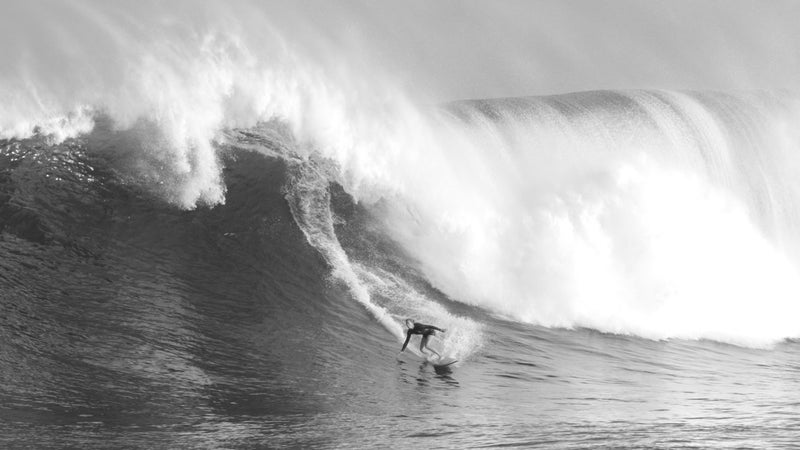My dream of surfing bigger waves took hold on a blue winter day several years ago, when I stood on a dune at San Francisco’s Ocean Beach and watched 20-foot swells peel into magnificent long walls. I was 45 years old, and I’d been surfing OB for 15 years, never venturing into anything above 10 or 12 feet, but all of a sudden I began thinking… maybe.
Before I explain why, and how it all worked out, I should clarify that nothing I’m describing qualifies as what I’d consider true big-wave surfing. I’ve seen the latter in an awful lot of movies, and with my own eyes at Maverick’s, 20 miles south of Ocean Beach, and at a break on Maui called Jaws. By some accounts, big-wave surfing doesn’t begin until the face hits 30 feet. It becomes serious around 40, and routinely sees elite riders rocketing across 70-footers.
In the context of the sport, in other words, my little midlife impulse toward bigger surf blew zero minds and qualified strictly as pushing a personal limit. Hundreds of men and women in California alone surf waves as big or bigger without a second thought. I’d ridden a few 18- to 20-footers myself—back in my twenties, when I lived in nearby Santa Cruz and my entire life revolved around catching waves, my daily schedule dictated by tide charts and wind patterns.
But then I moved to San Francisco, married and bought a house, and had kids—“the full catastrophe,” as Zorba the Greek puts it. Just crawling out of bed every morning, trying not to end up divorced or go bankrupt or traumatize my children, felt scary enough. Recreational terror held no appeal. A dear friend of mine named Mark Renneker surfed Maverick’s almost every time it broke, and he is quite a bit older than me. So I paddled out there once, caught a ballpark 30-footer, and duly wiped out. I told myself I didn’t need whatever Maverick’s had to offer and that anyone who did was nuts.

That left Ocean Beach, a world-class break that, while not a true big-wave spot, is notorious for North Pacific swells heaving into giant A-frames that detonate on shallow sandbars like bunker-busting bombs. Unlike Maverick’s or the waves near Santa Cruz, Ocean Beach lacks deep-water channels, so there’s no way to paddle from sand to surf without a beatdown. Before you can even try to catch a wave, you first have to paddle through 75 yards of relentlessly inbound walls of whitewater.
During small swells, those whitewater walls hit like distracted joggers, bouncing you around. On big days, they hit like NFL linemen in pillow suits—slamming you backwards so far it can take 45 minutes of lung-burning mortal combat just to reach the outer breakers, which is where the actual surfing happens.
Even then, the side-shore current sweeps south so fast that you might paddle parallel to the beach for an entire session just to stay near the best surf, which becomes a problem when an unusually huge wave looms into view and you’re too tired to sprint-paddle out of harm’s way. Taking a giant lip on the head, you can easily get blown back into the whitewater zone, and then, lacking the willpower to ram past all those linemen again, clear to the beach. The subsequent three hours of torpid, cranky exhaustion on your couch, nursing a beer and a burrito, do not square with family life.
But life has more seasons than we think. It’s not just spring, summer, autumn, and winter. If we have kids, they grow up and stop laughing at our jokes. If we suffer self-doubt and fear of failure—and who doesn’t, at least some of the time?—we realize that those feelings never really go away, so we learn to manage them like a chronic disease. Daily joys like surfing turn out to be strong medicine. New ambitions within those daily joys—deeper powder, tighter singletrack, more trail-running mileage—restore our sense of life as an adventure while anchoring us in the gentle sunshine of the present.
Better still, when we push limits in midlife, we get a much better idea of our actual physical capacity and needs. Like at Ocean Beach on that blue winter day: I was in great shape from a summer of triathlons, and I knew I’d be fine as long as I didn’t get seriously winded. So I pulled on a wetsuit, grabbed a surfboard, and started paddling, committed to remaining within myself, keeping calm.
I can’t say it was a glorious success. Forty minutes of battling whitewater got me to what we call the 80-yard line, a gauntlet blocking access to the good waves farther out. On that particular day, the 80-yard line consisted of a constant drumbeat of ten-foot waves slamming down hard enough to snap my board. I tried to ease my way across but got hit and drilled deep, flipped around like a toy soldier, and pushed to the beach.
In surfing terms, I got shut down—never reached the outside waves, much less caught one. But I was also unharmed and even unshaken, so I felt more as if a door had creaked ajar. I told Renneker about the experience, said I’d like to join him on bigger days. Next chance we got, he led me back through all that whitewater and taught me to bypass the 80-yard line by diving down and swimming along the dark sandy bottom while dragging my surfboard by the ankle leash. It worked. I was astonished to find myself alongside Renneker in the relative safety of the takeoff zone.
Looking back, if I see anything at all, it’s that initial instant when I’ve just caught a wave and stood up, taken control of my surfboard, and looked down the line of flight as if into a wormhole through emotional space-time, giddily anticipating the natural acceleration that obliterates self-awareness.
Watching those beastly things roll toward us, then floating up and over as they spun into foamy roaring tubes, felt like leaning over the balcony of the oceanic opera house and bearing witness to grandeur. Renneker rode several waves with such unfussy ease that I tried one myself, paddled hard as the wave bore down, felt my surfboard start to glide, and was about to hop to my feet when I looked down the blue cliff ahead and chickened out.
Ashore, Renneker kindly said it wasn’t my fault, that my surfboard was too small. He introduced me to a brilliant board designer named Dave Parmenter and helped me order a so-called big-wave gun—a nine-foot, six-inch spear painted fire-engine red.
I’ve been on this journey eight years now, constantly training to be fit enough. I swim laps in the off-season, lift weights, bodysurf. I wouldn’t say I’ve got anywhere near mastery, nor am I immune to serious thrashings, which I receive frequently. But there are beautiful moments, too—burned into memory as a fusion of feeling and image. Surfing’s weird that way. The focused fun of soaring on a great wave so deeply immerses one’s consciousness in flow that it’s quite normal to finish the ride of your life unable to replay it mentally. Looking back, if I see anything at all, it’s that initial instant when I’ve just caught a wave and stood up, taken control of my surfboard, and looked down the line of flight as if into a wormhole through emotional space-time, giddily anticipating the natural acceleration that obliterates self-awareness.
Curiously, though, I’ve found equal satisfaction in the discovery of genuine personal limits. A few months ago, again with Renneker, I paddled out in the biggest and most powerful surf I’d ever seen at Ocean Beach, each massive pulse like a runaway 18-wheeler speeding just under the surface, pushing us upward as it rolled below, then dropping us off its back. Renneker wasn’t remotely scared—he’s ridden 50-foot faces elsewhere—but I watched in astonishment as brilliant young surfers pulled into barrels the size of subway tunnels. When my own chance came, I paddled to the speeding brink of a watery cliff and, just as I had eight years before, chickened out. An hour later, I got another chance and had to yell at myself—for real, out loud—Don’t be scared! Don’t be scared! Hopping to my feet, I was airborne, separated from my surfboard and falling through space.
By the time I surfaced, I’d been pushed back across the 80-yard line, then well into the whitewater. Soon I was on shore. Walking up the grassy dune, I turned and saw Renneker, a tiny black figure on the now silver sea, glide along a mercury wall.
Later, as darkness fell and headlights gleamed on the city streets, he walked up, smiling. I told him how impressed I was, that I’d seen his ride and, having come up short myself, knew exactly how much skill it took. He said something equally kind—saw my wipeout, awesome that I’d tried, crazy-difficult conditions—and I realized I’d been wrong about Maverick’s, about big surf in general. I’d been wrong because I hadn’t known the pleasure that comes from really trying something at the outermost edge of one’s own ability—enjoying a certain pride, to be sure, but also earning the tenderness toward oneself and others that comes from authentic risk.


